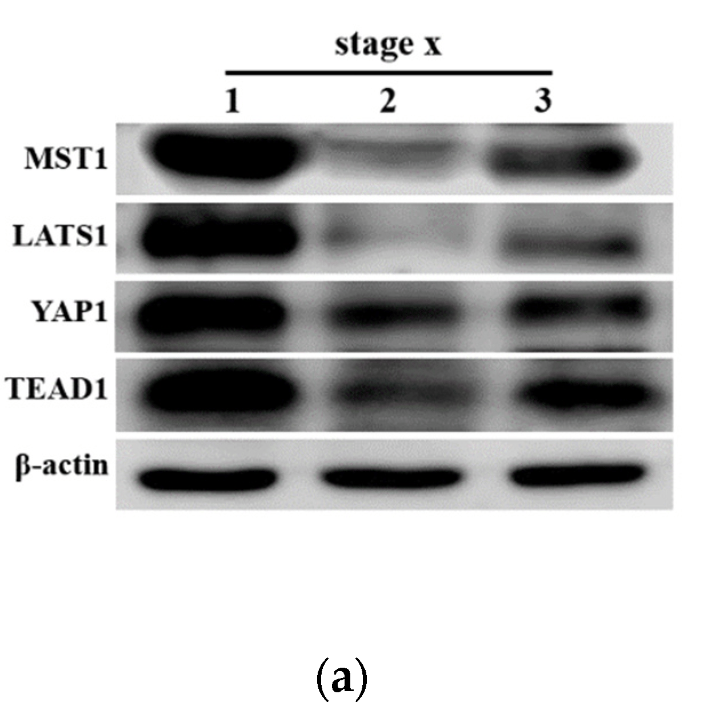TEAD1 Antibody - #DF3141
| Product: | TEAD1 Antibody |
| Catalog: | DF3141 |
| Description: | Rabbit polyclonal antibody to TEAD1 |
| Application: | WB IHC IF/ICC |
| Cited expt.: | WB |
| Reactivity: | Human, Mouse, Rat |
| Prediction: | Bovine, Horse, Sheep, Rabbit, Dog, Xenopus |
| Mol.Wt.: | 48 KD; 48kD(Calculated). |
| Uniprot: | P28347 |
| RRID: | AB_2835518 |
Related Downloads
Protocols
Product Info
*The optimal dilutions should be determined by the end user. For optimal experimental results, antibody reuse is not recommended.
*Tips:
WB: For western blot detection of denatured protein samples. IHC: For immunohistochemical detection of paraffin sections (IHC-p) or frozen sections (IHC-f) of tissue samples. IF/ICC: For immunofluorescence detection of cell samples. ELISA(peptide): For ELISA detection of antigenic peptide.
Cite Format: Affinity Biosciences Cat# DF3141, RRID:AB_2835518.
Fold/Unfold
DTEF 1; NTEF 1; Protein GT-IIC; SV40 transcriptional enhancer factor; TCF 13; TCF13; TEA domain family member 1; TEA domain family member 2; TEA domain family member 3; TEA domain family member 4; TEAD 1; TEAD 2; TEAD 3; TEAD 4; TEAD2; TEAD3; TEAD4; TEAD5; TEF1; TEF4; TEF5; Transcription factor 13; Transcription factor 13 like 1; Transcription factor RTEF 1; Transcriptional enhancer factor TEF 1; Transcriptional enhancer factor TEF 3; Transcriptional enhancer factor TEF 4; Transcriptional enhancer factor TEF 5;
Immunogens
A synthesized peptide derived from human TEAD1, corresponding to a region within the internal amino acids.
Preferentially expressed in skeletal muscle. Lower levels in pancreas, placenta, and heart.
- P28347 TEAD1_HUMAN:
- Protein BLAST With
- NCBI/
- ExPASy/
- Uniprot
MEPSSWSGSESPAENMERMSDSADKPIDNDAEGVWSPDIEQSFQEALAIYPPCGRRKIILSDEGKMYGRNELIARYIKLRTGKTRTRKQVSSHIQVLARRKSRDFHSKLKDQTAKDKALQHMAAMSSAQIVSATAIHNKLGLPGIPRPTFPGAPGFWPGMIQTGQPGSSQDVKPFVQQAYPIQPAVTAPIPGFEPASAPAPSVPAWQGRSIGTTKLRLVEFSAFLEQQRDPDSYNKHLFVHIGHANHSYSDPLLESVDIRQIYDKFPEKKGGLKELFGKGPQNAFFLVKFWADLNCNIQDDAGAFYGVTSQYESSENMTVTCSTKVCSFGKQVVEKVETEYARFENGRFVYRINRSPMCEYMINFIHKLKHLPEKYMMNSVLENFTILLVVTNRDTQETLLCMACVFEVSNSEHGAQHHIYRLVKD
Predictions
Score>80(red) has high confidence and is suggested to be used for WB detection. *The prediction model is mainly based on the alignment of immunogen sequences, the results are for reference only, not as the basis of quality assurance.
High(score>80) Medium(80>score>50) Low(score<50) No confidence
Research Backgrounds
Transcription factor which plays a key role in the Hippo signaling pathway, a pathway involved in organ size control and tumor suppression by restricting proliferation and promoting apoptosis. The core of this pathway is composed of a kinase cascade wherein MST1/MST2, in complex with its regulatory protein SAV1, phosphorylates and activates LATS1/2 in complex with its regulatory protein MOB1, which in turn phosphorylates and inactivates YAP1 oncoprotein and WWTR1/TAZ. Acts by mediating gene expression of YAP1 and WWTR1/TAZ, thereby regulating cell proliferation, migration and epithelial mesenchymal transition (EMT) induction. Binds specifically and cooperatively to the SPH and GT-IIC 'enhansons' (5'-GTGGAATGT-3') and activates transcription in vivo in a cell-specific manner. The activation function appears to be mediated by a limiting cell-specific transcriptional intermediary factor (TIF). Involved in cardiac development. Binds to the M-CAT motif.
Nucleus.
Preferentially expressed in skeletal muscle. Lower levels in pancreas, placenta, and heart.
Research Fields
· Environmental Information Processing > Signal transduction > Hippo signaling pathway. (View pathway)
· Environmental Information Processing > Signal transduction > Hippo signaling pathway - multiple species. (View pathway)
References
Application: WB Species: Mouse Sample:
Restrictive clause
Affinity Biosciences tests all products strictly. Citations are provided as a resource for additional applications that have not been validated by Affinity Biosciences. Please choose the appropriate format for each application and consult Materials and Methods sections for additional details about the use of any product in these publications.
For Research Use Only.
Not for use in diagnostic or therapeutic procedures. Not for resale. Not for distribution without written consent. Affinity Biosciences will not be held responsible for patent infringement or other violations that may occur with the use of our products. Affinity Biosciences, Affinity Biosciences Logo and all other trademarks are the property of Affinity Biosciences LTD.






